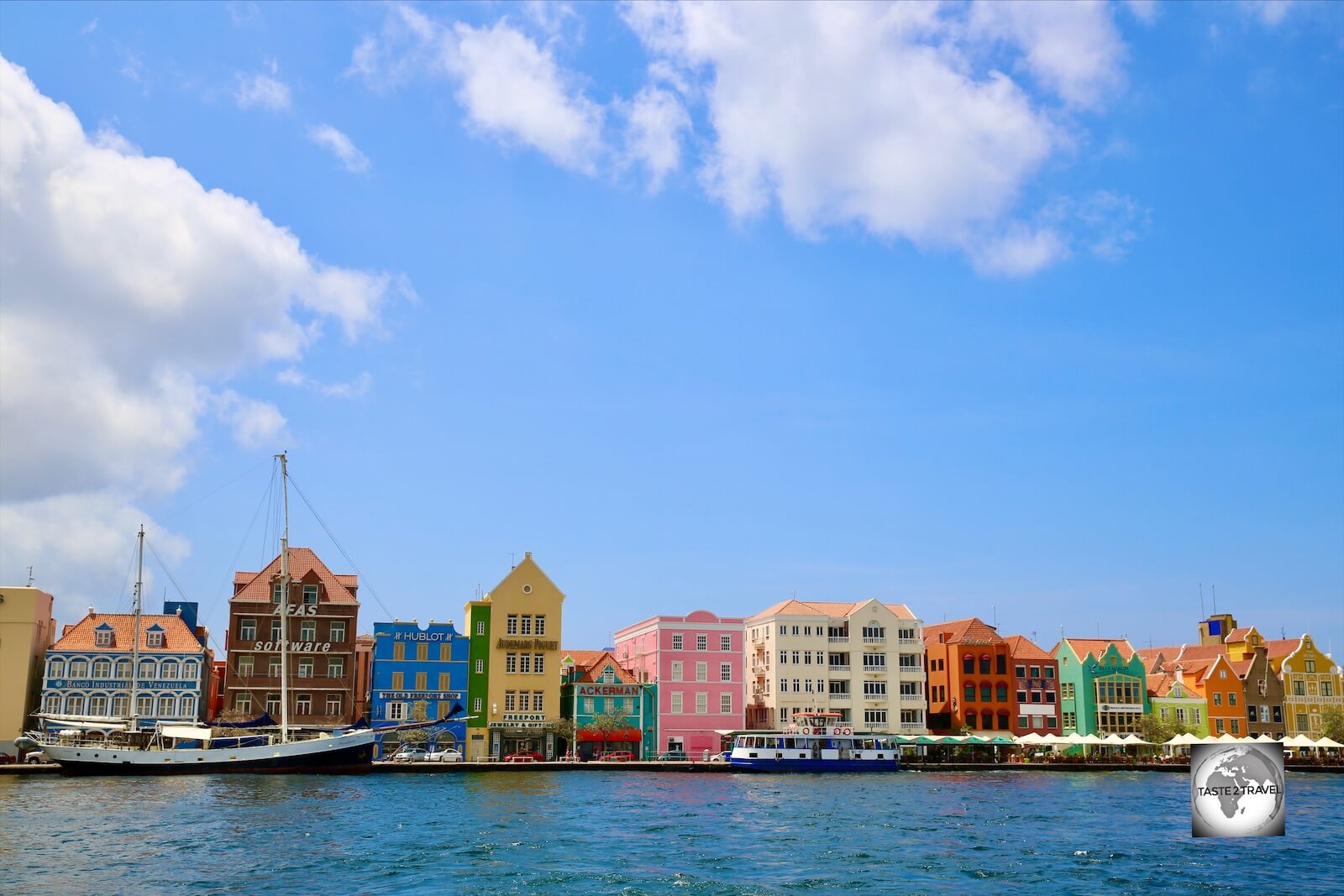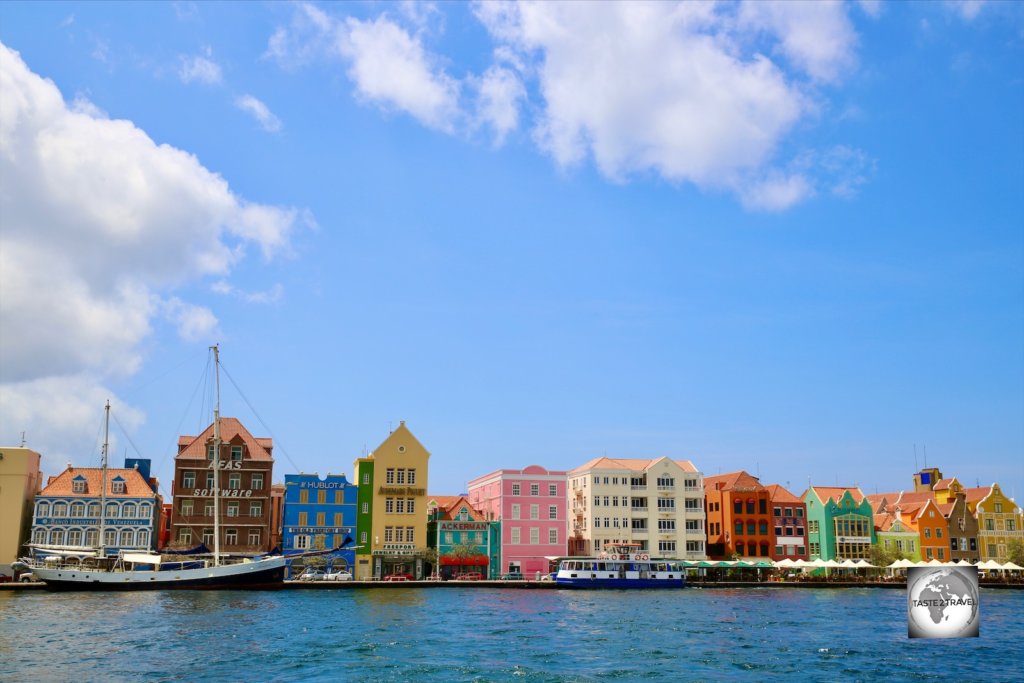Curaçao Travel Guide
Welcome to the taste2travel Curaçao Travel Guide!
Date Visited: March 2015
Introduction
Curaçao lies just to the north of the coast of Venezuela, east of Aruba and west of Bonaire and is one of the three ‘ABC’ islands (Aruba, Bonaire & Curaçao), which are all former Dutch colonies and are now part of the Dutch Caribbean.

Old Town of Willemstad, Curaçao.
Location
Curaçao forms part of the southwestern arc of the Lesser Antilles island chain and is located just 60 km (37 mi) north of the South American mainland and Venezuela (click the link to view my Venezuela Travel Report).
Aruba lies 113 km (70 mi) to the west, while Bonaire lies 82 km (51 mi) to the east.

A colourful map of Curaçao adorns a souvenir beach towel.
History

Colourful Dutch-style buildings line the iconic Handelskade in Willemstad, the capital of Curaçao.
The island was originally inhabited by Arawak Indians until the Spanish arrived in 1499 and enslaved them. The Dutch then took control of the island in 1634.
The Dutch East Indies Company founded the capital, Willemstad. The island had always been ignored because it lacked gold deposits but the natural harbour at Willemstad was ideal for trade.

The flag of Curaçao.
Commerce, shipping and piracy became the most important activities on the island and the island became a centre of the slave trade in the Caribbean. When slavery was abolished, many former slaves remained on the island and today Curaçao is the only one of the ABC islands with a substantial Afro population.

Sunset at Jan Thiel beach, which lies on the south coast of Curacao.
Curaçao is the largest and most populated (150,000) of the ABC islands. Public transport is available but limited. The best way to explore is to hire a car. I spent five days touring the island but you could cover all the sites in 2-3 days at a relaxed pace.
While Aruba attracts mainly American tourists, Curaçao attracts mainly Dutch tourists, who account for 32% of arrivals.

The Melocactus is a cactus species common to Curaçao.
Curaçao Liqueur

The name “Curaçao” has become associated with a shade of blue, because of the deep-blue version of the liqueur named Curaçao.
Curaçao’s most popular alcoholic beverage was discovered by accident when the Spanish Valencia orange was brought to the island, but unable to flourish in the climate. Instead, a bitter-tasting orange – the Lahara – was spawned.
The genuine Curaçao liqueur is made of the peels of the Laraha. It is produced in 5 different colours, the original clear liqueur, the famous Blue, Green, Red and Orange.
The Laraha plantation is on the east side of the island and has just 45 trees. Each tree produces on average 150 to 200 fruits and are harvested twice a year.
Free factory visits are available at Landhuis Chobolobo in Willemstad from Monday to Friday.
Sightseeing
Willemstad

A view of the colourful Handelskade, Willemstad.
Formerly the capital of the Netherlands Antilles (dissolved in 2010), the capital and largest city of Curaçao (population: 125,000), Willemstad is located on a deep natural harbour.
Many Dutch colonists grew affluent from the slave trade, and the city built impressive colonial buildings. Curaçao architecture blends Dutch and Spanish colonial styles. The wide range of historic buildings in and around Willemstad has resulted in the capital being designated as a UNESCO World Heritage Site.

The iconic, Dutch-style, Penha House dominates the Handelskade in downtown Willemstad.
The historic city centre is small and compact and can be explored easily on foot in a day. The downtown area consists of two districts: Otrobanda, the cultural centre of the city and Punda, they are separated by the St. Anna bay inlet. Willemstad is build around a natural harbour called the ‘Schottegat’.
The St. Anna bay inlet is bridged by the Queen Emma Pontoon bridge. This floating bridge pivots open to allow small and large (container ships) to pass through into the harbour. This is a great place for photography.

The Dutch-style Penha House stands out like a yellow beacon on the colourful Handelskade in downtown Willemstad.
In Punda you will find the colourful Handelskade, Amsterdam Fort, the main shopping area, the old food market (Plaz Bien), the oldest surviving (sand floor) synagogue in the Caribbean and the floating market, where boats come over from Venezuela to sell their produce. It’s all very lively and vibrant and worth the majority of your time in the city.

Display at the Kurá Hulanda Museum in Willemstad.
The highlight of Otrabanda (English: Other side) is the Kurá Hulanda Museum aka “Slave Museum”. The museum chronicles the origin of man, the African slave trade and West African empires. It is situated on the site of a former slave yard and merchant’s home.
Curaçao Beaches

The protected waters of Playa Lagoon are popular with families and provide excellent snorkelling.
Like Aruba, the best swimming beaches are located on the protected leeward side of the island (west coast) rather than the exposed windward side (east coast).
Unlike Aruba, the Curaçao coastline is made up of many protected coves rather than long stretches of white sandy beaches. All of these coves provide excellent snorkeling and diving opportunities.
Shete Boka National Park

Natural limestone bridge in Shete Boka National Park, Curaçao.
Worth a stop on the rugged east coast is this national park. Trails lead from a parking area to natural limestone bridges on the shore, sea-turtle sanctuaries, a big blowhole and isolated little beaches in narrow coves. Boka Tabla, a cave in the cliffs facing the water, is the most popular and closest walk.
The limestone here is razor sharp so good walking shoes are recommended – not your favourite pair of Havaianas.
Hato Caves

The interior of the Hato cave on Curaçao.
Located on the north side of the island, a short drive from the airport, the small Hato Cave is more than 300.000 years old, and has the distinction of being the largest cave on the island.
The cave has been open to visitors since 1990 and can be accessed by foot, after climbing 49 steps. Over millions of years, the island was formed in ‘terraces’ and while most caves are to be found in the second terrace, the Hato Cave is uniquely found in the third terrace of the island.
Accommodation

Sunset at Jan Thiel beach Curaçao.
Like neighbouring Aruba, this tourist haven is loaded with accommodation options catering for all budgets. Unlike Aruba accommodation is scattered around the island rather than concentrated in one beach-side location.
High season prices apply from December to April. Willemstad is far more interesting than Oranjestad (Aruba) so staying in the capital is worth considering. While on the island, I stayed at Jan Thiel beach which is located at the southern end of the island. The Hibiscus Beach House is a friendly Dutch-run B&B, which I would highly recommend.
Best to book ahead using an online agent such as booking.com
Eating Out
There are restaurants catering for all budgets scattered around the island.
One place worth exploring for cafes, bars, restaurants and nightlife is the trendy Willemstad neighbourhood of Pietersmaai
Visa Requirements
Some nationalities require visas for Curaçao – check your visa requirements prior to arrival.
Getting There
By Air
Flights into Curaçao arrive at Curaçao International Airport (IATA: CUR) which is located on the north coast of Curaçao, 12 kilometres (7.5 mi) from Willemstad. The airport serves as a main base for Divi Divi Air as well as EZAir and offers daily connections to many islands in the Caribbean region, South America, North America and Europe.
The following airlines provide scheduled services to/ from CUR:
- Air Canada – flies to/ from Toronto–Pearson
- Air Century – flies to/ from Santo Domingo–La Isabela
- American Airlines – flies to/ from Charlotte, Miami
- Aruba Airlines – flies to/ from Aruba, Bonaire
- Avianca – flies to/ from Bogotá
- Avior Airlines – flies to/ from Caracas
- Copa Airlines – flies to/ from Panama City
- Divi Divi Air – flies to/ from Aruba, Bonaire
- EZAir – flies to/ from Aruba, Bonaire
- Fly All Ways – flies to/ from Paramaribo, Santo Domingo–Las Americas
- JetBlue Airways – flies to/ from New York–JFK
- KLM – flies to/ from Amsterdam
- LASER Airlines – flies to/ from Caracas
- Sunrise Airways – flies to/ from Port Au Prince, Santo Domingo–Las Americas
- Sky High Aviation Services – flies to/ from Santo Domingo–Las Americas
- Surinam Airways – flies to/ from Paramaribo, Port of Spain
- TUI fly Netherlands – flies to/ from Amsterdam
- Winair– flies to/ from Aruba, Bonaire, Port-au-Prince, Santo Domingo-Las Américas, St. Maarten
- Wingo – flies to/ from Bogotá
Airport Transport
From the airport, taxis are available to any point on the island. There is no public transport from the airport but shuttle services can be booked. Your best option is to hire a car from the airport as public transport on the island is very limited.
By Sea
There are no scheduled ferry services connecting Curaçao to any other island. The only way to arrive by sea is by private yacht or cruise ship.
Cruise Ships dock at one of two terminals (Mega Pier Cruise-Terminal and Mathey Wharf) which are relatively close to each other, both at walking distance to the main attractions of Willemstad. You can view the current Cruise Ship Schedule here.
Getting Around

The license plate of my rental car on Curaçao.
Bus services on the island are provided by Autobusbedrijf Curaçao. Public transport on Curaçao is very limited. The two major bus stations are at Punda and Otrobanda.
The best option for exploring the island is to hire a car. The island can be covered in a day if you rushed around but at a more leisurely pace would require 2-3 days.
Safe Travels!
Darren
Follow me on Instagram:
[instagram-feed feed=1]
Further Reading
Other travel reports from the Caribbean region include:
Curaçao Travel Guide Curaçao Travel Guide Curaçao Travel Guide Curaçao Travel Guide Curaçao Travel Guide































